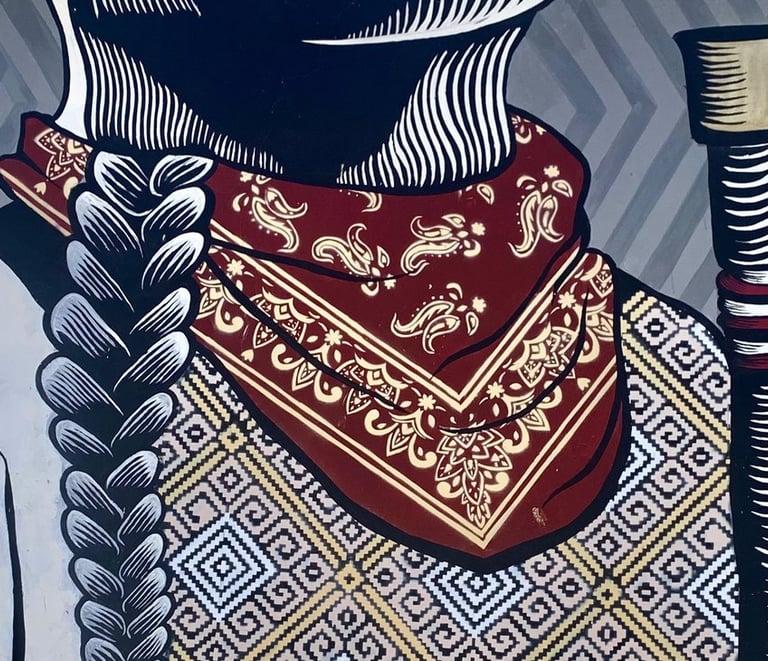What About the Zapatistas Now in Chiapas, Mexico?


After arriving in San Cristóbal de las Casas, it will not be long before you see photos, posters, murals, graphic t-shirts and even toy figurines depicting men and women wearing black balaclavas or red bandanas. These masked men and women are known as “Zapatistas,” a far-left revolutionary political and militant group, comprised mostly of disenfranchised Indigenous people living in rural areas of Chiapas who come from historically oppressed Mayan groups such as the Tzotzil, Tzeltal, and Chol.
Organized through the Zapatista National Liberation Army (known in Spanish as the EZLN, or Ejército Zapatista de Liberación Nacional), a guerilla group named after the peasant revolutionary Emiliano Zapata, a key figure of the Mexican Revolution of 1910-1920 who was assassinated in 1919, the Zapatista movement was founded in 1983 and began to attract many Indigenous followers beginning in the early 1990s.
While the Zapatista movement is decentralized, one masked figure stands out among the rest as their media figurehead. He is known as Subcommandante Marcos or Delegate Zero, and has become internationally famous as a rebel icon, recognized for his trademark black mask and pipe and for his communiques issued in the name EZLN. His communiques combine humour, poetry, storytelling, and political critiques that have been widely read in newspapers and on the internet around the world. They focus on human rights, international politics, Mayan culture, and are highly critical of neoliberalism (policies promoting free market trade) and globalization. His identity has never been confirmed, but he is thought to be Rafael Guillén Vicente, a philosophy professor who left academics to work with rural Indigenous peoples in Chiapas.
Subcommandante Marcos made his debut on the world stage on January 1, 1994, when the heavily armed EZLN seized control of San Cristóbal de las Casas and several other cities across Chiapas, occupying government buildings, freeing political prisoners, destroying land records, and expelling landowners from their estates. The EZLN staged this rebellion to protest economic policies, particularly NAFTA which came into effect the same day and included provisions to privatize Mexico’s ejidos (communal farms), which they believed would further impoverish Indigenous peoples. Other cited drivers for the armed rebellion include 500 years of struggle against slavery, imperialism, and dictatorships, as well as an ongoing ecological crisis, lack of available productive land, and drying up of nonagricultural sources of income.
The initial armed conflict between the EZLN and the Mexican Army lasted 12 days and resulted in the deaths of over 100 people, mostly Indigenous rebels. On January 12, 1994, a ceasefire was brokered and negotiations eventually led to signing of San Andres Accords in 1997, outlining program and land reform, Indigenous autonomy, and cultural rights. However, these were later rejected by Zedillo, the President of Mexico.
By 2001, the Mexican federal legislature approved revised San Andres Accords, but the EZLN denounced them and unilaterally declared that they were implementing the original accords in their territory. Several pro-Zapatista municipalities declared themselves autonomous from the state and federal governments in Mexico. Today, these municipalities continue to effectively govern themselves independently from Mexican authorities through “de facto autonomy” in the organization of daily life in their territory. They control a highly politically fragmented area roughly the size of Belgium.
Over the years, there have been periodic skirmishes between the EZLN and Mexican authorities, and tensions still exist today. However, the insurgency has largely shifted away from armed combat toward peaceful political action, and has developed into a forceful political movement advocating for disenfranchised Indigenous peoples. The Zapatistas continue to be vocal against “mega-projects” related to mining, energy, transportation and tourism in Mexico because of the impacts on Indigenous populations living in affected areas. For example, they have denounced the Mayan Train, a new rail system to link tourists to sights in the Yucatan Peninsula and Chiapas in Mexico.
The Zapatistas have brought unprecedented local, national and international attention to Indigenous rights in Mexico. The movement remains an incredible example of Indigenous people coming together to fight for their rights against the forces of colonialism and capitalism. Their primary goals continue to be land reform and redistribution, and greater political and cultural autonomy of Indigenous peoples living in Chiapas and the rest of Mexico. Since the rebellion of 1994, the Zapatistas have achieved a degree of autonomy, creating community-run schools, health clinics, and other institutions to serve poor rural communities in their territory. However, according to government data, the levels of poverty in Chiapas remain the worst in the country.
The Zapatistas also face new challenges in recent years with the arrival of major drug cartels, as well as the surge in Central and South American migrants in their territory. Cartels from the northern states of Sinaloa and Jalisco are fighting for control of lucrative trafficking routes for drugs, migrants, and guns. Local communities are subjected to harassment and violence by armed gangs, including threats, extortion, forced displacement, land theft, sexual violence, kidnapping and murder. In response to the escalation of violence and ramping up of militarization in the area, the EZLN recently announced the dissolution and reorganization of their self-governance model.
It remains unclear what the future holds for the Zapatista movement in Chiapas, including their struggles with Mexican authorities, poverty and drug cartels.


